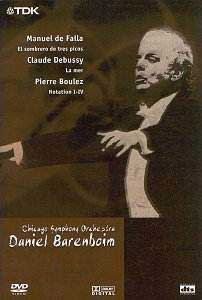The obvious advantage of DVD with a work as dense as
Notations I-IV is its capacity to help the listener pick out
individual threads of texture, but the necessary concomitant of a sound
quality to match the pin-sharp visuals is not met here. Focusing on
the first desk of the first violins as they twitter elegant trills near
the start of Notation II is not much use if you can’t hear what
they’re playing; leader Samuel Magad could be playing Ying-tong iddle
I po for all I can tell. The sound is selectively detailed, with percussion
and bassoon emerging vividly and this suggests poor microphone placement
rather than bad engineering.
You can hear enough to enjoy an elegant, almost nonchalant
performance of the Notations which rather underplays their moment-to-moment
switches of harmony and texture. They have almost become a ‘20th
Century Classic’ now, and I’m not sure that the status is good for them.
Barenboim plays them in the unusual order of 1-2-3-4; the composer,
Rattle and others switch 2 and 3 so that slow and fast pieces alternate.
Not only does this tactic give rest to the listener’s ear with the cool
sensuousness of no.2 but it accentuates the thrilling staircase of motifs
that rises through no.4 until its almighty final crash.
La mer is similarly detailed, sensitively played
and lacking idiom. De l’aude à midi sur la mer rocks becomingly
but the tempo changes and hesitations are just too obvious to be ardent.
Dialogue du vent et de la mer’s cheesy tune is resplendent enough
but there’s too little excitement generated prior to the peroration
to generate cumulative satisfaction.
That comes with an affectionate treatment of the dancing
Baroqueries in Falla’s Three-Cornered Hat, to which Elisabéte
Matos contributes assertively. Danza del corregidor has a rather
heavy tread, though its pulse is always maintained and Barenboim keeps
the textures light enough to highlight some superbly characterful solos.
His grunting, however, can’t quite keep the orchestra together at one
or two points in the fiendish cross rhythms of the final Jota.
Fans of the classic version by Ansermet may well be turned off by Barenboim’s
comparative lack of rhythmic bite and rounder-edged orchestral sound,
but I found his evident enjoyment of the music infectious. He also pitches
it at just the right level, halfway between local fun and Stravinskian
edginess.
The encore? Spanish fluff. The filler? No filler but
a display of intellectual fireworks from Pierre Boulez, with Barenboim
as a slightly otiose interlocutor. Its 10-minute duration is tantalisingly
brief and yet within that time Boulez throws off enough insightful observations
and reflections to provide food for thought for hours. Did you know
– would you expect? – that, ‘like all the French’, the Wagner Boulez
is most immediately attracted to is Tristan and Meistersinger?
Given his exclusive association until very recently (when he has programmed
the Prelude and Liebestod in concert) with Parsifal and
the Ring, it seems extraordinary. Boulez wears his years lightly
in spry intellect and appearance; by contrast Barenboim appears prematurely
aged. ‘We have to be aware of the past but we must not be prisoners
of the past’, concludes Boulez, and he appears to have learnt from his
words better than any of his contemporaries.
Peter Quantrill


![]() See
what else is on offer
See
what else is on offer 